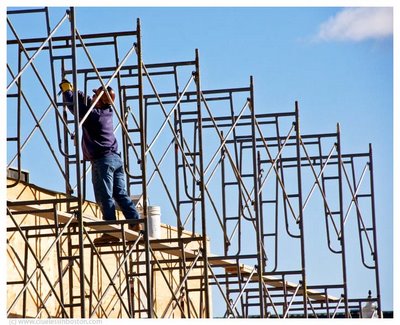Why Should Scaffolding Be Inspected?
OSHA (Occupational Safety and Health Administration) Standards Committee established and enforced a well-defined standard for the use of scaffolds since 1971, but scaffold related accidents continue to occur in the workplace, resulting in serious injury or death for numerous construction workers.
The Bureau of Labor Statistics reports that 72% of those unfortunately affected by a scaffolding related injury got wrapped up in a plank giving way, a portion of the support structure breaking down or merely slipped on a plank (this last one being the most common cause of scaffolding related accidents).
Though roughly three-quarters of these workers received formal training on scaffolding safety, and accidents occurred regardless of their knowledge. Realistically, the only way to ensure these scaffolding accidents decrease in frequency is to make regular inspections of the site’s scaffolding.
OSHA demands that scaffolds are to be inspected after installation/before first use, at least every week, and each time harsh weather conditions may have affected the integrity of the structure. However, it is ideal to inspect scaffolds much more than the bare minimum laid out by OSHA.
A scaffold inspection may be the difference between someone’s life and death. If someone is injured or dies because of a scaffolding accident, the company has liabilities as well. Companies can face noncompliance consequences and receive numerous citations from OSHA—these citations are also monetary penalties and will cost the company a hefty sum.
How to Inspect Scaffolding
First and foremost, it is of extreme importance that scaffolds should only be inspected by someone with adequate knowledge of scaffold safety. This person must receive proper training and experience before being assigned such a crucial task. If this individual finds an issue within the scaffolding, it is important for them to have the authority to demand that the appropriate safety measures be taken as well.
Building the Scaffold
Scaffold safety is compromised from the get-go if the scaffold is not built properly to begin with. The design for the scaffold must come from a licensed engineer who goes above and beyond the guidelines outlined by OSHA. Scaffolds that make use of anything other than scaffold grade materials must be rejected immediately, as using miscellaneous objects such as barrels and bricks to build a scaffold encourages weak composition.
Hazards Around the Scaffold
During a scaffold inspection, it is of the utmost importance to check that all power lines near the scaffolds are de-energized. There should be no active power lines, tools, or materials within 10 feet of the scaffold.
Safe access is another important thing to look out for. One should never use the scaffold itself as a ladder, and any ladders or stairways used to access the scaffold must be positioned strategically, as improper placement can threaten the stability of the structure.
Ladders must be securely attached to the scaffold, and any ladders must extend at least 3 feet above the scaffold’s platform. Overhead threats cannot be overlooked either, and if steady rain or harsh winds occur, scaffolding work should be halted immediately. Any spills that could cause one to slip must be cleaned immediately as well.
Structural Concerns
All planks used in scaffolding must be strong enough to sustain the predicted load amount, as it is important to never overload a scaffold. A scaffold’s support structure can never be removed without a proper replacement, otherwise, the scaffold is not fit for any use whatsoever. If a scaffold is over 10 feet in height, it needs additional guardrails on all open sides and ends, and horizontally smaller scaffolds may need these guardrails as well, regardless of height. Scaffolds over 10 feet in height must have toe-boards as well. The toe boards must be at least 4 inches high with a wire mesh over the gap between the toe board and the guardrail.
Ropes must be inspected before every work shift, as if the ropes possess defects and eventually snaps, there would be a tremendously horrific accident. If the scaffold is not suspended by ropes, it is still important to check the footings regularly to see if they are secure. The legs, posts, frames, and uprights must be securely attached to the baseplates and mudsills.
Planks must never have deep splits or warps greater than .25 inches. Long end splits, large loose knots, mold, and grain sloping found on planks means that plank is no longer fit for use. 10-foot planks or below must be 6 to 12 inches over the centerline of the support structure, and longer planks should not exceed 18 inches over the end.
Tagging
Scaffolds must also be tagged to indicate how safe they are after each scaffold inspection. Green tags indicate that the structure is completely safe for use, while yellow tags are used on scaffolds that were once unsafe but fixed for use again. These yellow tagged scaffolds may pose a threat but should be safe enough for work.
Once inspected again after permanent fixtures, the tag can be replaced to green or red depending on the inspector’s ruling. The importance of red tags can’t be stressed higher—red-tagged scaffolds that are no longer fit for use and should be immediately discarded!
Regular Inspection: Compliance and Injury Prevention
Regular inspection of scaffolding isn’t just good business practice it is a requirement to ensure your business meets safety code and OSHA requirements. Ensure your contractors, employees, and others remain safe and protected by following the tips in this guide.




